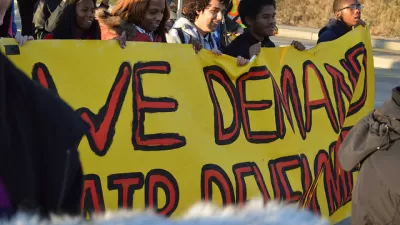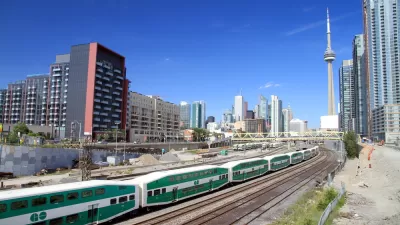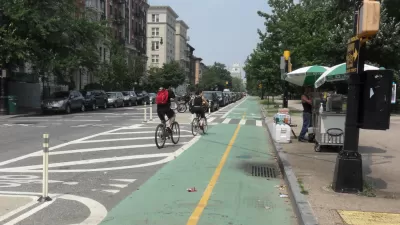Social / Demographics

The Economist and Suburbia: A Fistful of Myths
A recent set of articles in the Economist argued that the continued spread of suburbia was inevitable and perhaps desirable. But the article's arguments are not always applicable to North America.
Mind the Gap: Media, Researchers Identify Gentrification Differently
A new study by a sociologist at Louisiana State University examines the differences between qualitative and quantitative descriptions of gentrification. Even the New York Times, according to the study, reveals its bias.
Race, Poverty, and Change in America: The Persistent Dilemmas of Equity and Equality
The themes of race, poverty, and change in America are as relevant as ever, as our nation grapples with the recent tragedies in Ferguson, Missouri and Staten Island, New York.

Dumping in Dixie and the Inequity of Place
Only by better addressing issues of inequity can we create truly sustainable and livable communities. But is that even possible today?
California's Moderate Population Growth: The New Normal
New demographic data released Dec. 11 by the state Department of Finance shows the state grew by 335,000 people to 38.5 million, nearly one percent, despite a declining birth rate. While the most in six years, the growth rate has slowed overall.
Shared Kitchen Space: Best Culinary Innovation since the Food Truck?
Potentially the biggest culinary innovation since the gourmet food truck, L.A. Prep upholds principles of smart growth while supporting culinary entrepreneurs. Artisanal food producers will move into its 50 kitchens starting in January.
To Understand New York's Needs, Think Beyond Manhattan
When most people think of New York City, says CUNY planning professor and activist Tom Angotti, they think of Manhattan. This excessive focus on a narrow slice of the greater New York metropolitan area needs to be reconsidered.

Emerging Trends Report: Urbanization is the 'New Normal'
The Toronto Star picks up on the Urban Land Institute's Emerging Trends in Real Estate report, finding the trend of urbanization in Canada to reflect the trend in the United States.
Charting the Decline of Chicago's Middle-Class Neighborhoods
A post on the Chicago magazine site dives into research showing how Chicago has segregated by income since the 1970s.
Demographic Changes Mean a New Suburban American Dream
New Republic reprinted a portion of William Frey's new book, "Diversity Explosion: How New Racial Demographics are Remaking America."
Disappointment, Pessimism, Rage: Is this America at Middle Age?
Community conversations often devolve. Could it be partly due to the "midlife crisis" of the North American demographic? Can we look forward to a time of more social connectedness in the next decade, as we recalibrate to less "me," more "we?"
Selling Urbanism: Don’t be an Aristarchus
As urban planners, we must not only innovate, but make our innovations count in the marketplace of ideas. We must make the benefits of livability easily understood, with a clear path for making them happen. Scott Doyon encourages rooted innovation.

Goodbye Two-Car Household; Hello Rideshare and Carshare
A new study from KPMG predicts that the U.S. will go from a majority multi-car household to one where only 43% of households have more than one motor vehicle by 2040, and rideshare and car-share, along with demographic changes, will play key roles.
Urban Churches Adapt to a Changing City
In Washington, D.C., residents, shops and restaurants come and go, often moving from neighborhood to neighborhood. But churches remain. They anchor the community as it changes, and often find themselves changing with it.

Why Accusations of 'Racism' Don't (Usually) Work
Conservatives and liberals tend to define "racism" very differently. As a result, accusations of racism tend to be unsuccessful outside ideologically homogenous environments.
The Human Dimension of the Physical City
In his latest two contributions from the south of France, Chuck Wolfe reminds urbanists of the backdrop of the human dimension of affinity, conversation and daily rituals that stand behind the physical, human scale.

The Chicken and the Egg: Gentrification and Bicycling
Shaun Courtney examines the current politics surrounding gentrification and bicycling throughout the country and what planners can do to address the issue.
Study Complicates Relationship of Population Growth, Emissions Reduction
More people translates to more emissions, right? Cut back on population growth and you'll reduce emissions and the threat of climate change, along with other environmental woes—it's a no-brainer. Or is it?
How to Solve the Pension Challenge
Diana Lind of Next City poses five ways big cities can alleviate some of their pension funding problems.
2050: Year of the Minority Majority
Tanvi Misra discusses with William Frey of the Brooking Institution the repercussions of the demographic flip expected to occur by 2050.
Pagination
Urban Design for Planners 1: Software Tools
This six-course series explores essential urban design concepts using open source software and equips planners with the tools they need to participate fully in the urban design process.
Planning for Universal Design
Learn the tools for implementing Universal Design in planning regulations.
Gallatin County Department of Planning & Community Development
Heyer Gruel & Associates PA
JM Goldson LLC
City of Camden Redevelopment Agency
City of Astoria
Transportation Research & Education Center (TREC) at Portland State University
Jefferson Parish Government
Camden Redevelopment Agency
City of Claremont


































